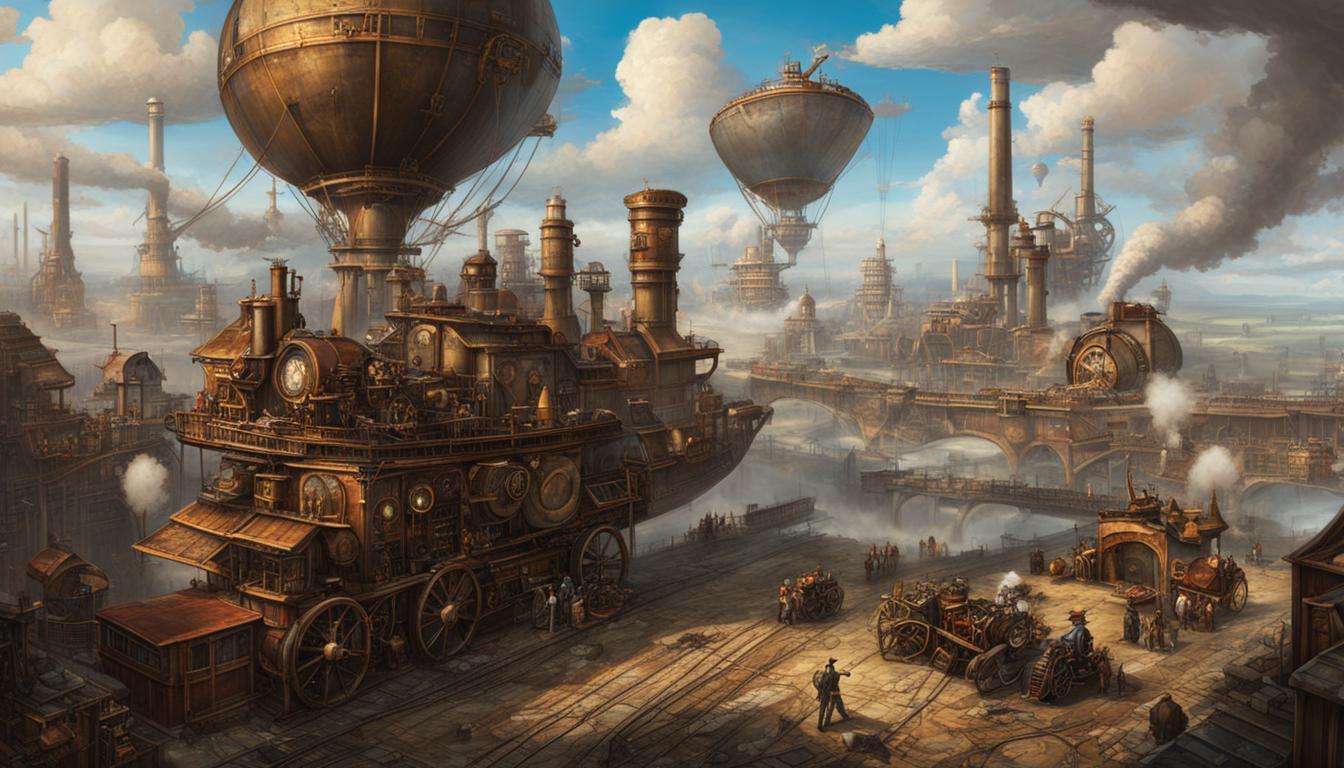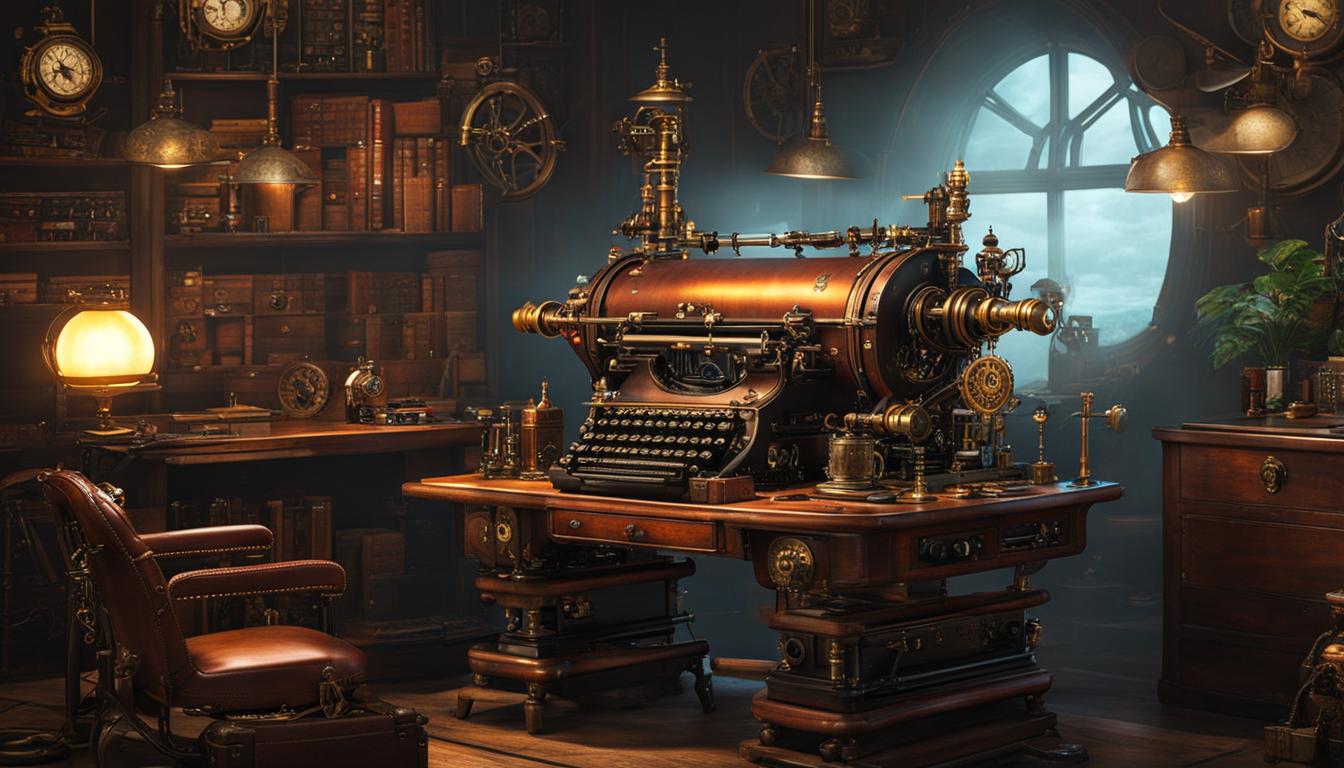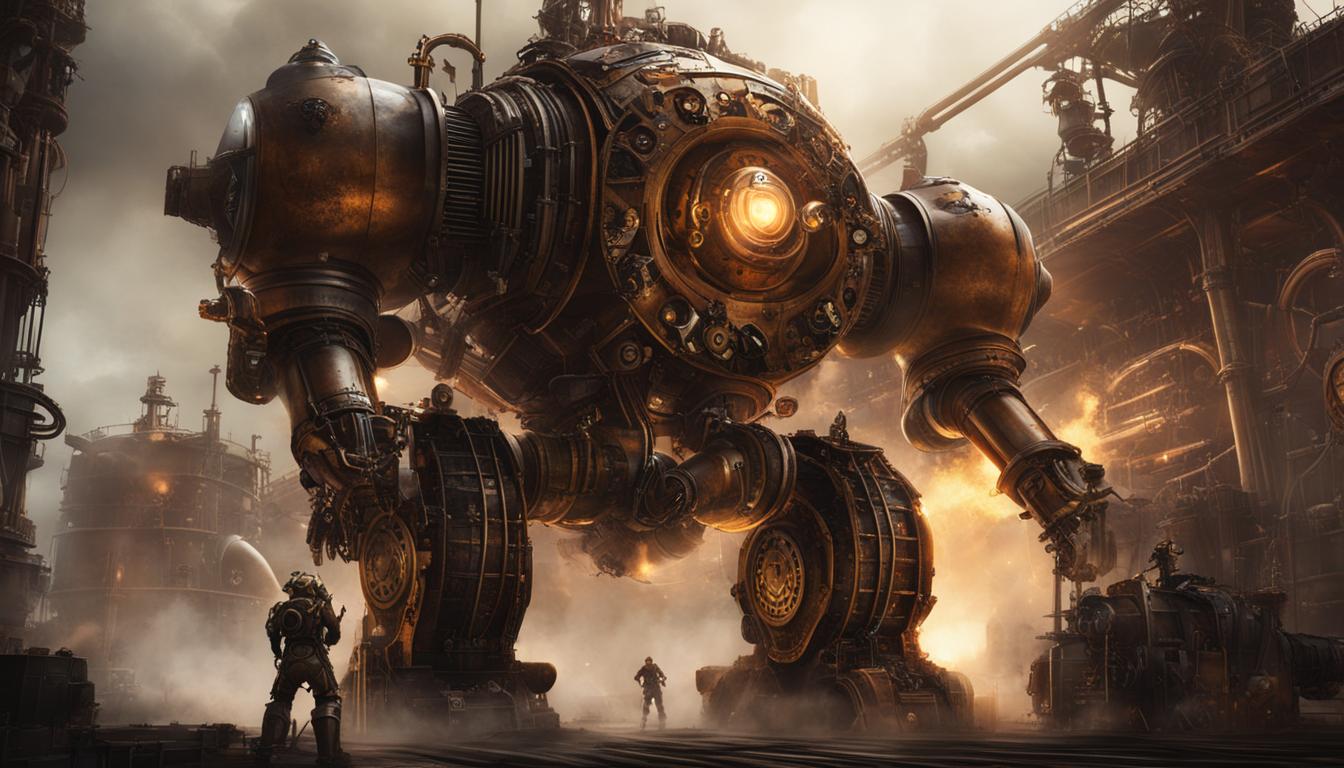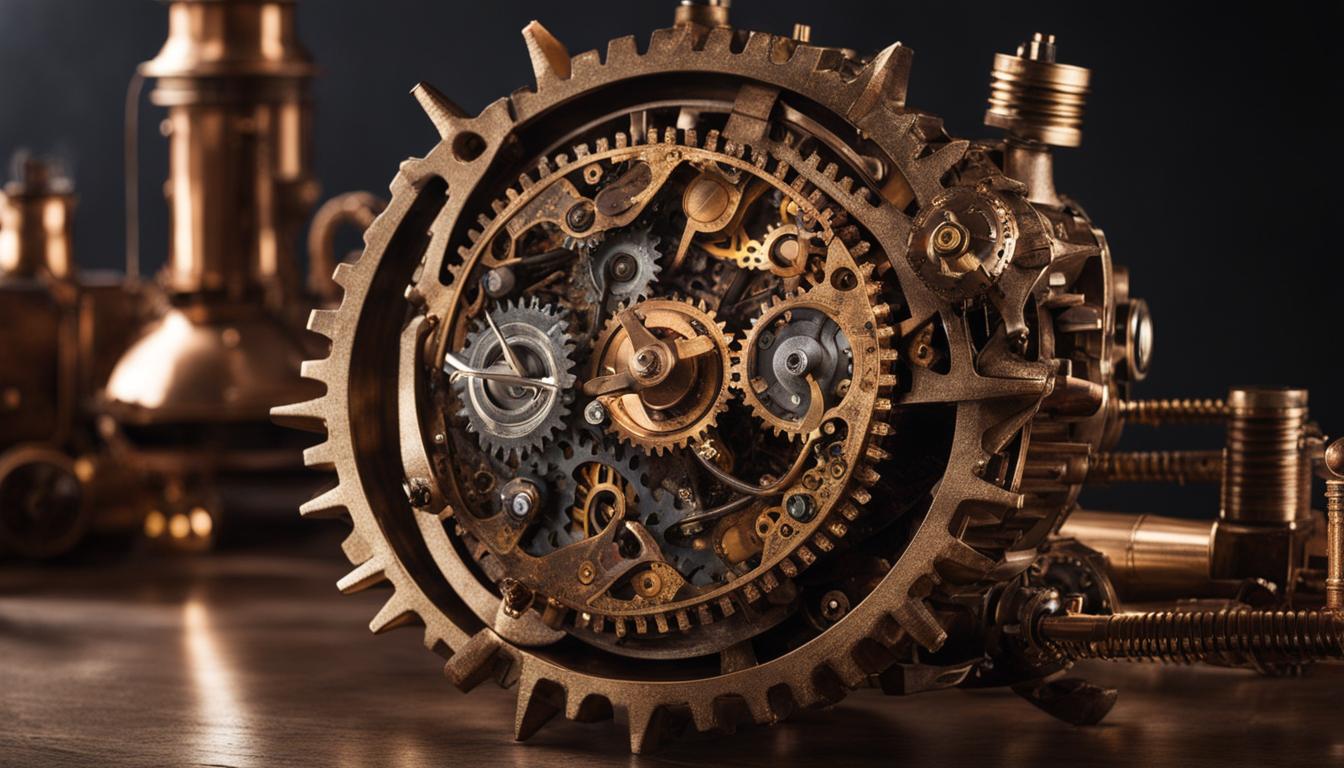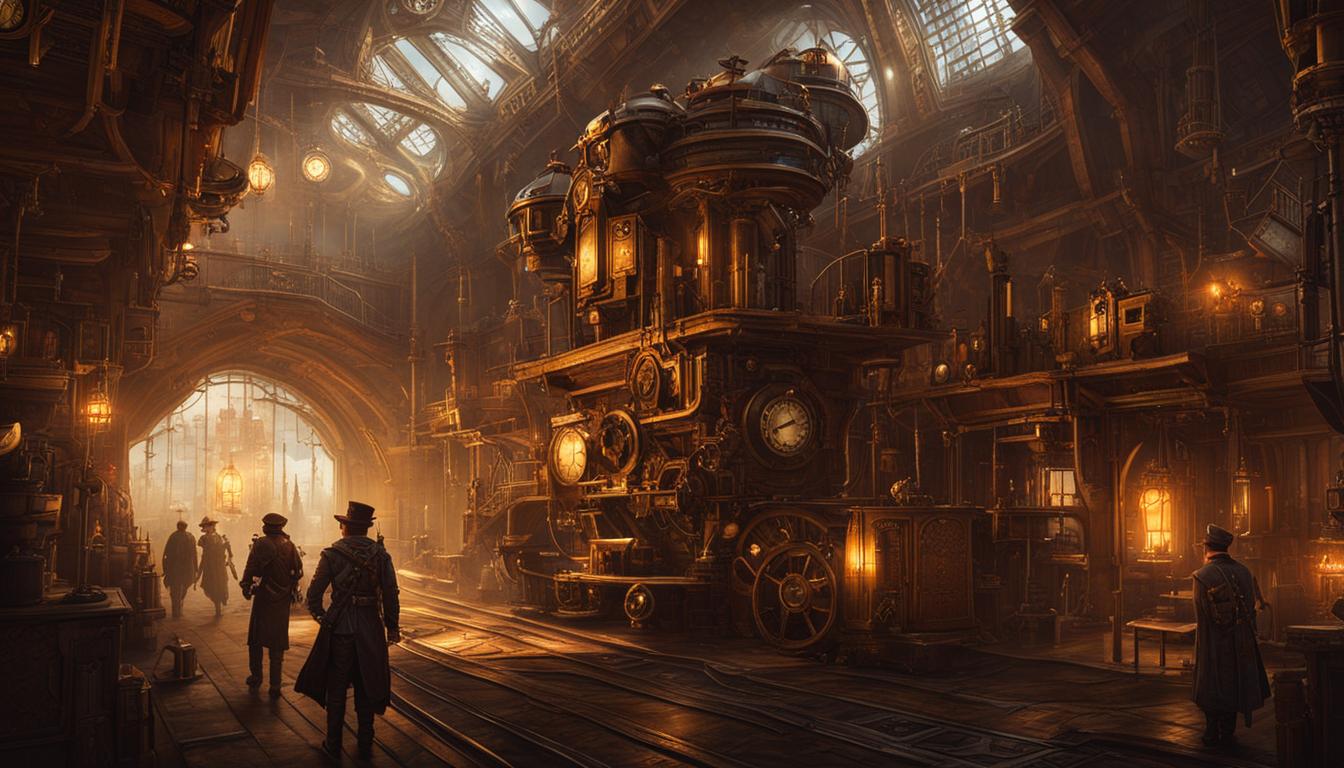Steampunk art is a captivating blend of past and future, combining Victorian aesthetics with futuristic elements. It transcends various forms of artistic expression, including fashion, literature, films, and architecture. The key elements of steampunk art include gears and cogs, brass and copper, clocks and timepieces, and airships and flying machines.
Key Takeaways:
- Steampunk art blends Victorian aesthetics with futuristic elements
- Gears and cogs, brass and copper are central to steampunk art
- Steampunk art encompasses fashion, literature, films, and architecture
- Clocks, timepieces, airships, and flying machines are iconic in steampunk art
- Steampunk game design creates visually stunning and immersive experiences
Exploring the History of Steampunk Art
Steampunk art has a fascinating history that intertwines with the literary world. It originated in the late 20th century as a subgenre of science fiction, envisioning alternative histories where steam power remained dominant. The term “steampunk” was coined by author K.W. Jeter in 1987, differentiating it from the cyberpunk genre. Since then, steampunk art has grown into a thriving field with a dedicated community of creators and enthusiasts.
Steampunk art emerged from the pages of books, capturing the imaginations of readers with its unique blend of Victorian aesthetics and futuristic technology. It drew inspiration from the works of Jules Verne and H.G. Wells, who popularized the idea of steam-powered machines and fantastical contraptions. As the concept of steampunk expanded beyond literature, it found expression in various artistic mediums, including fashion, films, and, of course, video games.
Steampunk arose from the literary world, springing forth from the minds of visionary authors and captivating readers with its imaginative fusion of past and future.
Steampunk art’s roots in literature provide a rich foundation for its development as a visual art form. It allows artists to explore themes of adventure, exploration, and innovation while staying true to the Victorian era’s elegance and charm. Steampunk game designers, in particular, have been drawn to the genre’s narrative potential and distinct aesthetic, bringing the world of steampunk to life in interactive and immersive experiences.
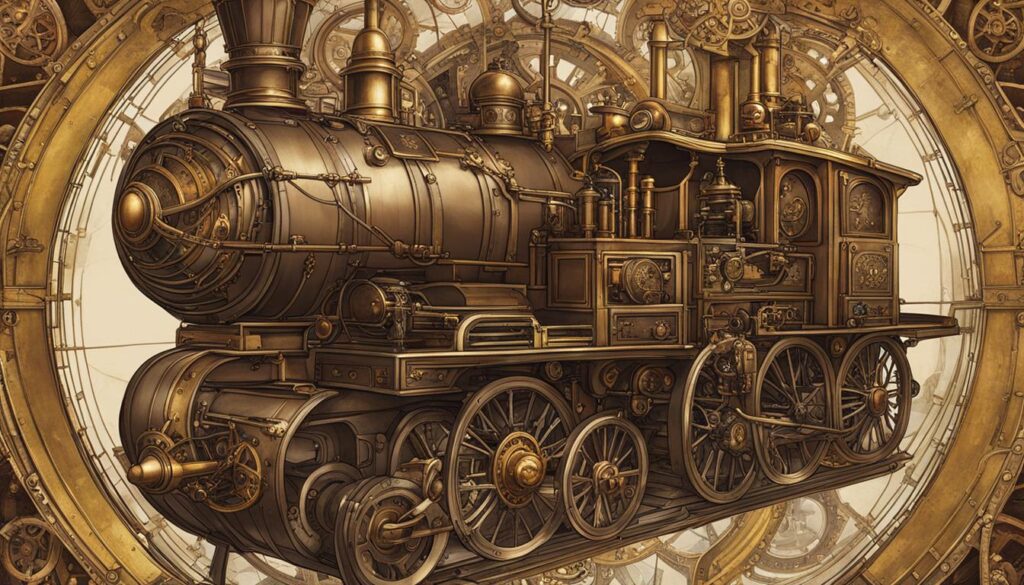
The Rise of Steampunk in Popular Culture
With its romanticized vision of the past and its imaginative take on the future, steampunk has captured the attention of pop culture enthusiasts around the world. It has become a source of inspiration for filmmakers, fashion designers, and artists alike. Steampunk-themed conventions and events have emerged, allowing fans to gather and celebrate their shared love for this unique genre.
Table: Key Moments in the History of Steampunk Art
| Year | Event |
|---|---|
| 1987 | K.W. Jeter coins the term “steampunk” in a letter to Locus Magazine |
| 1990s | The term gains popularity among science fiction fans and authors |
| 2003 | The “Steampunk Bible” by Jeff VanderMeer and S.J. Chambers is published, showcasing the breadth of steampunk art and culture |
| 2009 | Movie adaptations of steampunk-inspired books, such as “Sherlock Holmes” and “The League of Extraordinary Gentlemen,” bring the genre to mainstream audiences |
| 2010s | Steampunk conventions and festivals gain popularity worldwide, showcasing the creativity and enthusiasm of the steampunk community |
Steampunk art continues to evolve and captivate audiences with its fusion of history, fantasy, and adventure. Its allure lies in its ability to transport us to a world where steam-powered marvels exist alongside corsets and top hats, where the past melds with the future in a whirlwind of creativity and imagination.
Blending Victorian Aesthetics with Future Elements in Steampunk Art
Creating steampunk art involves merging the elegance of the Victorian era with the intrigue of a steam-powered future. It’s a delicate balance between the past and the future, where brass and lace coexist in harmony with gears and flying machines. In the world of steampunk art, the possibilities are endless, and artists are constantly pushing the boundaries of imagination.
Victorian aesthetics play a crucial role in the visual language of steampunk art. Delicate lace, intricate patterns, and sumptuous fabrics like velvet evoke the elegance and refinement of the 19th century. These elements, combined with the gritty, industrial feel of machinery and steam power, create a unique juxtaposition that is visually captivating. Steampunk art invites viewers to indulge in a nostalgia for an imagined past while also inviting them to dream of a fantastical future.
When integrating steampunk art into video games, designers have the opportunity to create immersive and visually stunning experiences. The attention to detail required in blending Victorian aesthetics with futuristic elements can elevate the game’s atmosphere and make it truly memorable. Whether it’s designing characters with elaborate steampunk-inspired costumes or creating intricate game environments filled with whimsical contraptions, integrating art into steampunk video games adds depth and richness to the gameplay.
Steampunk art is a testament to human imagination and the power of creativity. By merging elements of the past and future, it allows us to explore new possibilities and alternative realities. Whether it’s in literature, fashion, or video games, steampunk art continues to inspire and captivate audiences worldwide.
Exploring Steampunk Art Styles and Themes
Steampunk art is a rich and diverse genre that encompasses a wide range of styles and themes. From industrial to romantic, explorer to post-apocalyptic, each style brings its own unique flavor to the world of steampunk. Let’s dive into the various steampunk art styles and themes that have captivated artists and gamers alike.
Industrial Steampunk
Industrial steampunk art focuses on the mechanical side of the genre, depicting complex machinery, gears, and cogs. It embraces the industrial revolution aesthetic, with a gritty and industrialized look. Artists delve into the intricacies of steam-powered contraptions, showcasing the beauty in the mechanical workings of their creations.
Romantic Steampunk
Romantic steampunk art is a celebration of Victorian fashion and elegance. It places a strong emphasis on the refined aesthetics of the Victorian era, incorporating elements such as lace, corsets, top hats, and waistcoats. This style often showcases the grandeur of lavish ballrooms and sophisticated society, intertwining romance with the steampunk world.
Explorer Steampunk
Explorer steampunk art brings a sense of adventure and discovery to the genre. It portrays intrepid explorers venturing into uncharted territories, with airships soaring through the skies and diving bells exploring the depths of the oceans. This style evokes a spirit of exploration and curiosity, capturing the thrill of uncovering hidden wonders in a steam-powered world.
Post-Apocalyptic Steampunk
Post-apocalyptic steampunk art imagines a world where society has collapsed, and steam power becomes the driving force for survival. This style often showcases a gritty, desolate landscape, with dilapidated buildings and scavenged machinery. It combines the allure of the past with the challenges of a futuristic and harsh reality.
These are just a few examples of the diverse steampunk art styles and themes that have emerged within the genre. Whether you’re drawn to the mechanical intricacies of industrial steampunk, the romance of Victorian aesthetics, the thrill of exploration, or the post-apocalyptic vision of a steam-powered future, there’s a steampunk art style that will resonate with you.
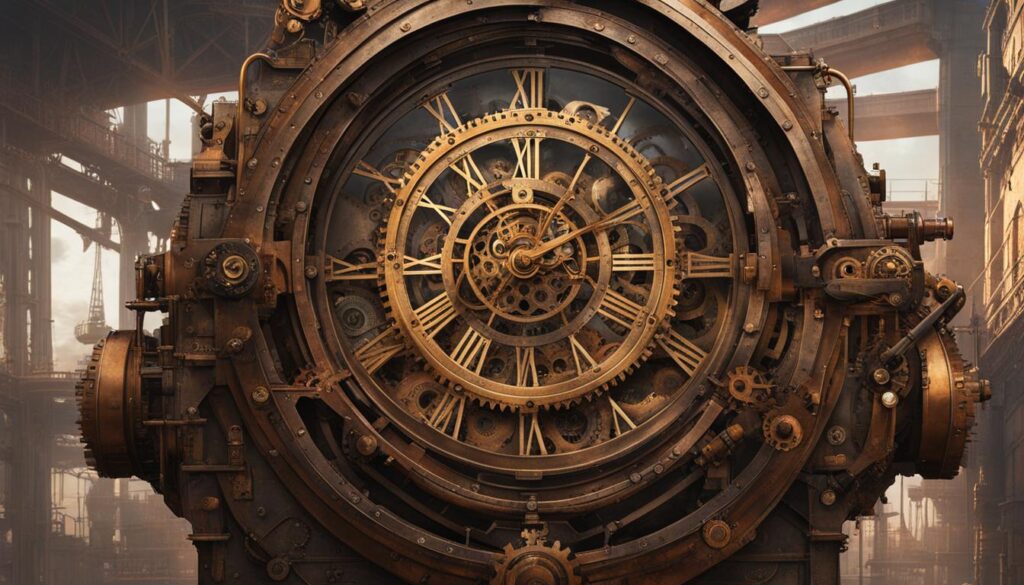
| Steampunk Art Style | Description |
|---|---|
| Industrial Steampunk | Focuses on the mechanical side of steampunk, featuring complex machinery and gears. |
| Romantic Steampunk | Celebrates Victorian fashion and elegance, showcasing refined aesthetics. |
| Explorer Steampunk | Brings a sense of adventure and discovery, emphasizing exploration and curiosity. |
| Post-Apocalyptic Steampunk | Imagines a steam-powered future after societal collapse, with a gritty and desolate landscape. |
Essential Materials and Tools for Creating Steampunk Art
Creating visually stunning steampunk games requires a careful selection of materials and tools. The essence of steampunk art lies in the intricate details and textures that bring the genre to life. From metal and leather to gears and delicate trinkets, here are some essential materials and tools to consider when crafting your own steampunk masterpiece.
Materials for Steampunk Art:
- Metal: Incorporate brass, copper, and other metals to create a vintage and industrial aesthetic. These materials can be used in crafting props, sculptures, or even jewelry.
- Leather: Add a touch of ruggedness and authenticity with leather. It can be used for clothing, accessories, or as a base for various steampunk creations.
- Wood: Opt for weathered or aged wood to enhance the antique feel of your steampunk art. It can be used for furniture, boxes, or as a canvas for painting.
- Watch Parts and Gears: Salvage old watches or clocks to acquire unique gears, cogs, and other intricate components. These elements can be used to embellish steampunk accessories or as decorative accents.
When it comes to tools, the specific requirements will depend on the nature of your project. However, there are some general tools that are commonly used in steampunk art:
Tools for Steampunk Art:
- Pliers: Essential for bending, shaping, and manipulating metal components.
- Sewing Needles: Perfect for working with fabric and leather, allowing you to stitch together various steampunk garments or accessories.
- Hot Glue Gun: An indispensable tool for securing different materials together, especially when working with delicate components.
- Paintbrushes: Use a range of brushes to apply paint or distress various surfaces, achieving the desired vintage or industrial effect.
- Dremel Tool: Ideal for precision cutting, drilling, and engraving on different materials, including metal and wood.
Remember, the most important tool for creating steampunk art is your imagination. Let your creativity run wild as you combine different materials and experiment with various techniques. Embrace the beauty of the past and the excitement of the future to craft visually stunning steampunk games that captivate and inspire.
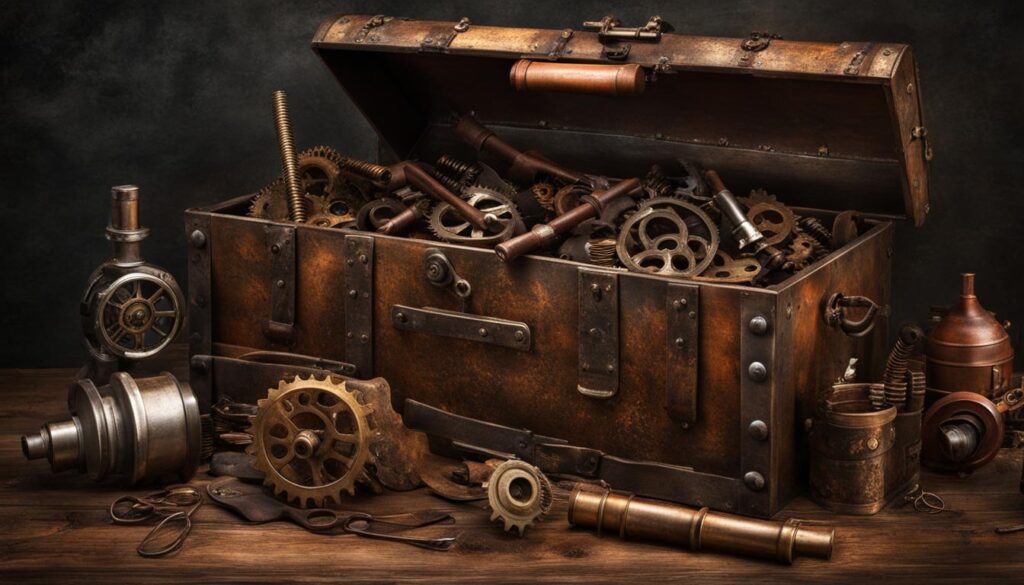
The Allure of Artistic Elements in Steampunk Game Design
Steampunk game design is a mesmerizing fusion of the past and the future. It transports players to a world where Victorian aesthetics intertwine with futuristic contraptions, creating visually stunning and immersive experiences. The role of art in steampunk gaming is paramount, as it adds depth and richness to the genre, captivating players with its unique artistic elements.
From the mesmerizing gears and cogs to the gleaming brass and copper, the visual appeal of steampunk games is undeniable. These artistic elements not only embellish the game world but also serve a functional purpose, breathing life into steam-powered machinery and airships. They evoke a sense of wonder and curiosity, transporting players to a fantastical realm where imagination knows no bounds.
Art-focused steampunk video game concepts push the boundaries of creativity. They draw inspiration from various artistic mediums, including literature, fashion, and pop culture. Steampunk art has left an indelible mark on these games, inspiring developers to craft visually stunning environments, intricate character designs, and captivating storylines that immerse players in the steampunk universe.
Steampunk game design has become an art form in itself, capturing the hearts and minds of players around the world. The allure of its artistic elements, coupled with the enticing blend of past and future, continues to propel the genre forward. As technology advances, we can only imagine the breathtaking possibilities that await in the future of steampunk gaming.
FAQ
What are the key elements of steampunk art?
The key elements of steampunk art include gears and cogs, brass and copper, clocks and timepieces, and airships and flying machines.
When and how did steampunk art originate?
Steampunk art originated in the late 20th century as a type of science fiction that depicted alternative histories where steam power remained dominant. It was coined by author K.W. Jeter in 1987, distinguishing it from cyberpunk.
What styles and themes can be found in steampunk art?
Steampunk art encompasses a wide range of styles and themes, including industrial steampunk, romantic steampunk, explorer steampunk, and post-apocalyptic steampunk.
What materials and tools are used in creating steampunk art?
Steampunk art relies on materials like metal, leather, and wood to create a textured and visually interesting aesthetic. Incorporating old watch parts, gears, and mechanical components can add a signature steampunk touch. The tools needed depend on the project, such as pliers for working with metal or sewing needles for fabric.
What role do artistic elements play in steampunk game design?
Artistic elements add depth and richness to steampunk games, creating visually stunning and immersive experiences. From gears and copper to Victorian aesthetics and futuristic contraptions, the unique artistic elements bring the steampunk world to life.
How does steampunk art influence game development?
Steampunk art has made its mark in various forms of artistic expression, including literature, fashion, and pop culture. Its visually captivating and imaginative elements continue to inspire new creations in the genre, making crafting visually stunning steampunk games an art form in itself.

